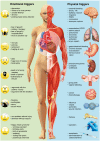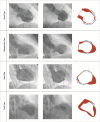International Expert Consensus Document on Takotsubo Syndrome (Part I): Clinical Characteristics, Diagnostic Criteria, and Pathophysiology - PubMed (original) (raw)
. 2018 Jun 7;39(22):2032-2046.
doi: 10.1093/eurheartj/ehy076.
Ilan Shor Wittstein 2, Abhiram Prasad 3, Scott Sharkey 4, Keigo Dote 5, Yoshihiro John Akashi 6, Victoria Lucia Cammann 1, Filippo Crea 7, Leonarda Galiuto 7, Walter Desmet 8 9, Tetsuro Yoshida 10, Roberto Manfredini 11, Ingo Eitel 12, Masami Kosuge 13, Holger M Nef 14, Abhishek Deshmukh 3, Amir Lerman 3, Eduardo Bossone [ 15](#full-view-affiliation-15 "Heart Department, University Hospital "San Giovanni di Dio e Ruggi d'Aragona", Salerno, Italy."), Rodolfo Citro [ 15](#full-view-affiliation-15 "Heart Department, University Hospital "San Giovanni di Dio e Ruggi d'Aragona", Salerno, Italy."), Takashi Ueyama 16, Domenico Corrado 17, Satoshi Kurisu 18, Frank Ruschitzka 1, David Winchester 19, Alexander R Lyon 20 21, Elmir Omerovic 22 23, Jeroen J Bax 24, Patrick Meimoun 25, Guiseppe Tarantini 17, Charanjit Rihal 3, Shams Y-Hassan 26, Federico Migliore 17, John D Horowitz 27, Hiroaki Shimokawa 28, Thomas Felix Lüscher 29 30, Christian Templin 1
Affiliations
- PMID: 29850871
- PMCID: PMC5991216
- DOI: 10.1093/eurheartj/ehy076
International Expert Consensus Document on Takotsubo Syndrome (Part I): Clinical Characteristics, Diagnostic Criteria, and Pathophysiology
Jelena-Rima Ghadri et al. Eur Heart J. 2018.
Abstract
Takotsubo syndrome (TTS) is a poorly recognized heart disease that was initially regarded as a benign condition. Recently, it has been shown that TTS may be associated with severe clinical complications including death and that its prevalence is probably underestimated. Since current guidelines on TTS are lacking, it appears timely and important to provide an expert consensus statement on TTS. The clinical expert consensus document part I summarizes the current state of knowledge on clinical presentation and characteristics of TTS and agrees on controversies surrounding TTS such as nomenclature, different TTS types, role of coronary artery disease, and etiology. This consensus also proposes new diagnostic criteria based on current knowledge to improve diagnostic accuracy.
Figures
Figure 1
Historical Japanese octopus trap (left). Courtesy of Dr Templin, University Hospital Zurich, Zurich, Switzerland. Left ventriculogram of the first reported case of takotsubo syndrome. Diastole (A) and systole (B) during the acute phase of takotsubo syndrome. Recovery of left ventricular wall motion abnormality two weeks after the event (C and D). Courtesy of Dr Dote, Hiroshima City Asa Hospital, Hiroshima, Japan.
Figure 2
Age and sex distribution of patients with takotsubo syndrome. Reprinted with permission from Templin et al.
Figure 3
Emotional and physical stress factors precipitating takotsubo syndrome. Reprinted, modified, and translated with permission from Schlossbauer et al. COPD, chronic obstructive pulmonary disease; PRES, posterior reversible encephalopathy syndrome; TIA, transient ischaemic attack.
Figure 4
The four different types of takotsubo syndrome during diastole (left column) and systole (middle column). The right column depicts diastole in red and systole in white. The blue dashed lines demonstrate the region of the wall motion abnormality. Reprinted and modified with permission from Templin et al.
Comment in
- Takotsubo syndrome's pathophysiology: still a mystery?
Pelliccia F, Kaski JC, Camici PG. Pelliccia F, et al. Eur Heart J. 2019 Jun 21;40(24):1989. doi: 10.1093/eurheartj/ehz083. Eur Heart J. 2019. PMID: 30903135 No abstract available.
Similar articles
- Coronary vasospasm is an unlikely cause of Takotsubo syndrome, although we should keep an open mind.
Madias JE. Madias JE. Int J Cardiol. 2014 Sep;176(1):1-5. doi: 10.1016/j.ijcard.2014.06.069. Epub 2014 Jul 5. Int J Cardiol. 2014. PMID: 25043215 - Takotsubo syndrome: State-of-the-art review by an expert panel - Part 1.
Dias A, Núñez Gil IJ, Santoro F, Madias JE, Pelliccia F, Brunetti ND, Salmoirago-Blotcher E, Sharkey SW, Eitel I, Akashi YJ, El-Battrawy I, Franco E, Akin I, Jaguszewski M, Dawson D, Figueredo VM, Napp LC, Christensen TE, Hebert K, Ben-Dor I, Ozaki Y, García-Garcia HM, Kajita AH, Akasaka T, Kurisu S, Lerman A, Waksman R. Dias A, et al. Cardiovasc Revasc Med. 2019 Jan;20(1):70-79. doi: 10.1016/j.carrev.2018.11.015. Epub 2018 Nov 17. Cardiovasc Revasc Med. 2019. PMID: 30528096 Review. - Why the current diagnostic criteria of Takotsubo syndrome are outmoded: a proposal for new criteria.
Madias JE. Madias JE. Int J Cardiol. 2014 Jul 1;174(3):468-70. doi: 10.1016/j.ijcard.2014.04.241. Epub 2014 Apr 29. Int J Cardiol. 2014. PMID: 24820748 - Takotsubo syndrome and coronary microcirculation dysfunction: Vasospasm or damage due to adjacent cardiomyocyte injury and/or myocardial edema?
Madias JE. Madias JE. Int J Cardiol. 2016 Jul 15;215:90-1. doi: 10.1016/j.ijcard.2016.04.117. Epub 2016 Apr 13. Int J Cardiol. 2016. PMID: 27111167 No abstract available. - International Expert Consensus Document on Takotsubo Syndrome (Part II): Diagnostic Workup, Outcome, and Management.
Ghadri JR, Wittstein IS, Prasad A, Sharkey S, Dote K, Akashi YJ, Cammann VL, Crea F, Galiuto L, Desmet W, Yoshida T, Manfredini R, Eitel I, Kosuge M, Nef HM, Deshmukh A, Lerman A, Bossone E, Citro R, Ueyama T, Corrado D, Kurisu S, Ruschitzka F, Winchester D, Lyon AR, Omerovic E, Bax JJ, Meimoun P, Tarantini G, Rihal C, Y-Hassan S, Migliore F, Horowitz JD, Shimokawa H, Lüscher TF, Templin C. Ghadri JR, et al. Eur Heart J. 2018 Jun 7;39(22):2047-2062. doi: 10.1093/eurheartj/ehy077. Eur Heart J. 2018. PMID: 29850820 Free PMC article.
Cited by
- Sympathetic nerve activity and response to physiological stress in Takotsubo syndrome.
Ekenbäck C, Persson J, Tornvall P, Forsberg L, Spaak J. Ekenbäck C, et al. Clin Auton Res. 2024 Nov 15. doi: 10.1007/s10286-024-01082-9. Online ahead of print. Clin Auton Res. 2024. PMID: 39546154 - Myocardial Infarction with Normal Coronary Arteries.
Raizner AE. Raizner AE. Methodist Debakey Cardiovasc J. 2024 Nov 5;20(5):124-127. doi: 10.14797/mdcvj.1495. eCollection 2024. Methodist Debakey Cardiovasc J. 2024. PMID: 39525371 Free PMC article. - Novel method for diagnosing takotsubo syndrome with left ventriculography using a microaxial flow pump in temporary surgical mode in a patient with cardiogenic shock: a case report.
Kawakami S, Nawata E, Nishi JI. Kawakami S, et al. Eur Heart J Case Rep. 2024 Oct 24;8(11):ytae578. doi: 10.1093/ehjcr/ytae578. eCollection 2024 Nov. Eur Heart J Case Rep. 2024. PMID: 39502260 Free PMC article. - Takotsubo Syndrome-Induced Cardiogenic Shock in Lung Transplantation: Importance of Early Diagnosis and ECMO Implantation.
Boudart C, Assam O, Veliziotis I, Vander Kuylen M, Perrin L. Boudart C, et al. Am J Case Rep. 2024 Nov 5;25:e944942. doi: 10.12659/AJCR.944942. Am J Case Rep. 2024. PMID: 39497380 Free PMC article. - Regional mechanical dyssynchrony and shortened systole are present in people with Takotsubo syndrome.
Reil JC, Sequeira V, Reil GH, Steendijk P, Maack C, Fink T, Rawish E, Eitel I, Stiermaier T. Reil JC, et al. Commun Med (Lond). 2024 Nov 1;4(1):223. doi: 10.1038/s43856-024-00641-5. Commun Med (Lond). 2024. PMID: 39487225 Free PMC article.
References
- Sato H. Tako-tsubo-like left ventricular dysfunction due to multivessel coronary spasm In: Kodama K, Haze K,, Hori M, eds. Clinical Aspect of Myocardial Injury: From Ischemia to Heart Failure. Tokyo: Kagakuhyoronsha Publishing Co; 1990. p56–64; (Article in Japanese).
- Sharkey SW, Shear W, Hodges M, Herzog CA.. Reversible myocardial contraction abnormalities in patients with an acute noncardiac illness. Chest 1998;114:98–105. - PubMed
- Wittstein IS, Thiemann DR, Lima JA, Baughman KL, Schulman SP, Gerstenblith G, Wu KC, Rade JJ, Bivalacqua TJ, Champion HC.. Neurohumoral features of myocardial stunning due to sudden emotional stress. N Engl J Med 2005;352:539–548. - PubMed
Publication types
MeSH terms
Substances
LinkOut - more resources
Full Text Sources
Other Literature Sources



